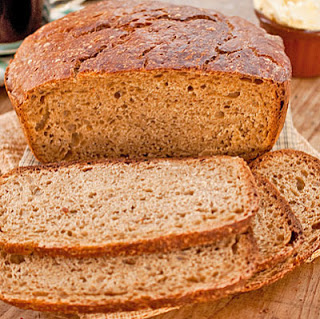 I am a huge fan of Guinness Extra Stout. Not because I care much for dark, strong beers; except at an occasional Orioles’ game or as an accompaniment to peppery Chesapeake steamed crabs, I skip even regular beers because they seem, well, too strong. (Did you know that the word “stout” actually means “strong” in old Irish lingo?)
I am a huge fan of Guinness Extra Stout. Not because I care much for dark, strong beers; except at an occasional Orioles’ game or as an accompaniment to peppery Chesapeake steamed crabs, I skip even regular beers because they seem, well, too strong. (Did you know that the word “stout” actually means “strong” in old Irish lingo?)
Not because I enjoy quaffing a few brews and partying with friends on St. Paddy’s Day either. My hubby and I are of Scottish, German, English, and possibly Welsh descent, so our modest nod to the holiday usually includes eating a requisite potato dish for dinner and perhaps wearing something green! I also make decorated shamrock cut-out cookies for my grandchildren.
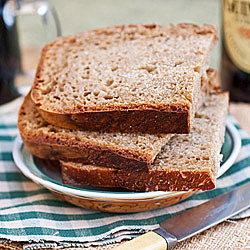 For me (and maybe for many people) a lot of the appeal of Guinness stout comes from its high nostalgia factor. The memorable brand logo, an ancient golden O’Neill harp historically associated with Irish Nationalist movements (above the word Guinness on the bottle below), started appearing on Guinness products in 1862! By then Guinness had already been around for more than a century; brewing began in Dublin at the St. James’s Gate brewing facility in 1759. I’d really like to imagine thirsty Dubliners gathering to chat and hoist their pints in a quaint, long-ago neighborhood pub on St. Patrick’s Day–except I know they didn’t! Boston was the first place to celebrate the day in 1737. It was many decades before the holiday took hold back in the homeland (mainly to attract an American tourist trade!)
For me (and maybe for many people) a lot of the appeal of Guinness stout comes from its high nostalgia factor. The memorable brand logo, an ancient golden O’Neill harp historically associated with Irish Nationalist movements (above the word Guinness on the bottle below), started appearing on Guinness products in 1862! By then Guinness had already been around for more than a century; brewing began in Dublin at the St. James’s Gate brewing facility in 1759. I’d really like to imagine thirsty Dubliners gathering to chat and hoist their pints in a quaint, long-ago neighborhood pub on St. Patrick’s Day–except I know they didn’t! Boston was the first place to celebrate the day in 1737. It was many decades before the holiday took hold back in the homeland (mainly to attract an American tourist trade!)
 In fact, my great enthusiasm for Guinness Extra Stout comes mostly from the fact that it makes a fine, very distinctive yeast bread! I use a whole 1-pint, 6-ounce bottle of it in place of water in a simple no-knead, no-fuss bread formula. The result is a big, rustic, hearty-looking loaf with a decidedly chewy texture and a complex grain taste that’s extremely mellow and enticing and not (surprisingly) beery or bitter. The stout, which is itself a deep, ruby-black shade, also lends the bread a gorgeous and unusual ruddy tinge. The slices are excellent with slivers of sharp cheddar cheese, even better amply spread with good butter.
In fact, my great enthusiasm for Guinness Extra Stout comes mostly from the fact that it makes a fine, very distinctive yeast bread! I use a whole 1-pint, 6-ounce bottle of it in place of water in a simple no-knead, no-fuss bread formula. The result is a big, rustic, hearty-looking loaf with a decidedly chewy texture and a complex grain taste that’s extremely mellow and enticing and not (surprisingly) beery or bitter. The stout, which is itself a deep, ruby-black shade, also lends the bread a gorgeous and unusual ruddy tinge. The slices are excellent with slivers of sharp cheddar cheese, even better amply spread with good butter.
To keep preparations as absolutely simple as possible, once the dough is stirred together and covered, I just put it aside in a chilly (60-degree F) room and let it rise, completely unattended, for about 24 hours. If you don’t have a garage, unheated sun room, basement, or other spot quite this cool, the dough will rise faster, so check to see if it is bubbly all over and tripled in bulk after 18 hours. In any case, don’t skimp on the rising time, as this allows for the fullest gluten development (visible in the stirred-down dough at right) and yields the noticeably chewy, springy crumb. Before baking the dough will smell of stout and taste strong, but somehow the heat gentles and sweetens it nicely in the oven.
- 5 cups (25 ounces) unbleached all-purpose white flour, plus more as needed
- 1 teaspoon rapid rising, bread machine, or “instant,” yeast
- 1 1-pint, 6-ounce bottle well-chilled Guinness Extra Stout
- ¼ cup clover honey or other mild honey
- 1 tablespoon canola or similar vegetable oil, plus more for brushing dough top
- 2 teaspoons plain table salt
- In a large bowl thoroughly stir together the flour and yeast. In a small, deep bowl, thoroughly stir together about ½ cup stout, the honey, oil and the salt until the honey is thoroughly incorporated into the stout. Add the remainder of the bottle of stout and the stout-honey mixture to the flour mixture. Vigorously stir with a large wooden spoon until the bubbling subsides and the dough is thoroughly blended. It should be stiff and hard to stir; if the dough is soft and wet, vigorously stir in more flour until it is hard to stir and mounds up a bit, but should not be dry.
- Thoroughly scrape down the bowl sides. Turn the dough out into a well-oiled 4-quart or larger bowl. Brush or spray the dough top with oil. Oil one side of a sheet of plastic wrap, then place it oil-side down over the bowl. Pull it tight over the bowl to keep the dough from drying out. Set the bowl in a 60-degree F (or similar) room and let the dough rise 18 to 24 hours or until bubbly and at least tripled in bulk.
- Vigorously and thoroughly stir down the dough with a large wooden spoon; it will feel rubbery and resistant as you stir. Brush and smooth the dough surface with oil. Re-cover the bowl with the oiled plastic wrap. Let rise using either of these methods: for a 1½- to 2½-hour regular rise, let stand at warm room temperature; for a 45-minute to 2-hour accelerated rise, let stand in a turned-off microwave along with 1 cup of boiling-hot water. Continue the rise until the dough doubles from the deflated size; remove the plastic if the dough nears it.
- About 20 minutes before baking time, put a rack in the lower third (but not the very bottom) of the oven; preheat to 425 degrees F. Heat a 4-quart (or similar) heavy metal pot or Dutch oven or a deep 4-quart heavy, oven-proof saucepan in the oven until sizzling hot (check with a few drops of water), then remove it, using heavy mitts. Spritz the pot interior with non-stick spray (or wipe it with a few swipes of an oiled paper towel). Taking care not to deflate the dough, loosen it from the bowl sides with an oiled rubber spatula and gently invert it into the pot. Don’t worry if it’s lopsided and ragged-looking; it will even out during baking. Very generously spritz or brush the top with water. Immediately top with the lid. Shake the pot back and forth to center the dough.
- Reduce the heat to 400 F. Bake on the lower rack for 55 to 60 minutes, or until the loaf top looks tawny brown and crisp. Remove the lid. Bake for 10 to 15 minutes longer, or until the top is well browned and a skewer inserted in the thickest part comes out clean except for a few crumbs on the tip (or until the center registers 208 to 210 degrees F on an instant-read thermometer). If the loaf begins to over-brown at any point, cover it with foil. And bake 5 minutes longer than you think the loaf needs to ensure the center is baked through. Cool in the pan on a wire rack. Remove the loaf to the rack. Cool thoroughly. Makes 1 very large loaf, 13 to 15 slices.
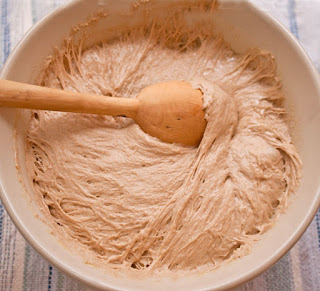
If you’re new to no-knead yeast bread, note that it’s the bubbling action during the long fermentation that actually kneads the dough. This recipe is similar to many in my Kneadlessly Simple: Fabulous, Fuss-Free, No-Knead Breads, in case you’re interested in trying other breads or learning more. For a tempting no-knead focaccia from the book, go here. For details on how my no-knead method works, go here.
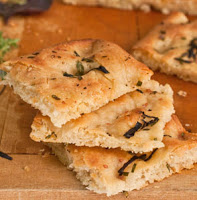
For a totally different, but equally appealing no-knead bread, check out my Kneadlessly Simple thin focaccia here.
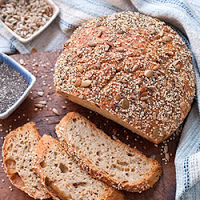
Or, perhaps you’d like the crusty seeds-a-plenty boule.
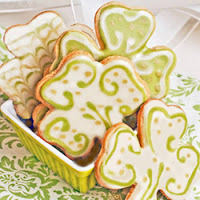
Or, if you’re into St. Patrick’s Day, but not bread, how about my green tea shamrock cookies?
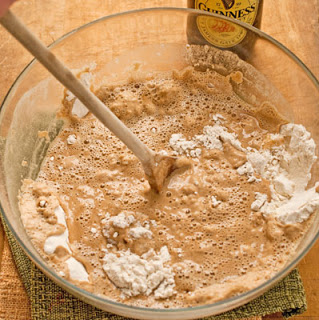

A pint is 2 cups, 6 ounces is 3/4 cup. They are the same.
I’m not sure about the amount of stout. You mention a pint, 6 ounces and also 2 & 3/4cups.
Right, much better than drinking it!
Like you, I'm not much for beer drinking. But the bread sounds wonderful.
After reading your comments, I'm going to go have a slice of that bread right now!
Stout is a favorite with me. Love the rich, peaty flavor. So this easy-to-make-bread is on my "to do" agenda for St. Pat's Day. With a hunk of Dunbliner cheddar, a strong cuppa Bewley's tea and one of Tana Franch's Irish-set detective novels in my lap, I'm set to celebrate.
I love stout, so this will be a perfect bread for me, I'm sure. Much better than green beer…or bread.